Deflation 2009 as Central Bank Credit Creation Loses to Derivatives Deleveraging
Economics / Deflation Dec 15, 2008 - 09:32 PM GMTBy: John_Mauldin

 This week I am really delighted to be able to give you a condensed version of Gary Shilling's latest INSIGHT newsletter for your Outside the Box. Each month I really look forward to getting Gary's latest thoughts on the economy and investing. Last year in his forecast issue he suggested 13 investment ideas, all of which were profitable by the end of the year. It is not unusual for Gary to give us over 75 charts and tables in his monthly letters along with his commentary, which makes his thinking unusually clear and accessible.
This week I am really delighted to be able to give you a condensed version of Gary Shilling's latest INSIGHT newsletter for your Outside the Box. Each month I really look forward to getting Gary's latest thoughts on the economy and investing. Last year in his forecast issue he suggested 13 investment ideas, all of which were profitable by the end of the year. It is not unusual for Gary to give us over 75 charts and tables in his monthly letters along with his commentary, which makes his thinking unusually clear and accessible.
Gary was among the first to point out the problems with the subprime market and predict the housing and credit crises. You can learn more about his letter at http://www.agaryshilling.com. If you want to subscribe, you can call 888-346-7444. Tell them that you read about it in Outside the Box and you will get not only his 2009 forecast issue but an extra issue with his 2010 forecast (of course, that one will not come out for a year. Gary is good but not that good!)
I trust you are enjoying the holidays. And enjoy this week's Outside the Box.
John Mauldin, Editor
Outside the Box
Semi-Annual U.S. Economic Outlook:
Collapsing On Schedule
by Gary Shilling
The recession is now running on all four cylinders. We're referring to the four phases of the downturn that we identified much earlier and discussed in numerous Insights.
Phase 1, the collapse of the housing sector, touched off by the subprime slime, as we dubbed it, and measured by the ABX BBBindex, started early last year with the $1.8 billion writedown of subprime mortgage securities by big U.K. bank HSBC in February. Phase 2, the spreading of the woes to Wall Street, commenced with the implosion of two big Bear Stearns hedge funds in June 2007. These first two phases are largely financial, and persist today.
Housing Horrors
Housing starts have nosedived from 2.3 million, seasonally adjusted at annual rates, in January 2006 to 791,000 in October, a post-World War II low (Chart 1). Meanwhile, homebuilder sentiment is now at record lows. Leaping foreclosures, among other forces, have pushed up the homeowner vacancy rate. Some of the victims of declining homeowner rates are moving into rental apartments as the bubble years' lure of homeownership fades or they lose their houses. But others are doubling up with friends and family, thereby adding to empty house inventories.
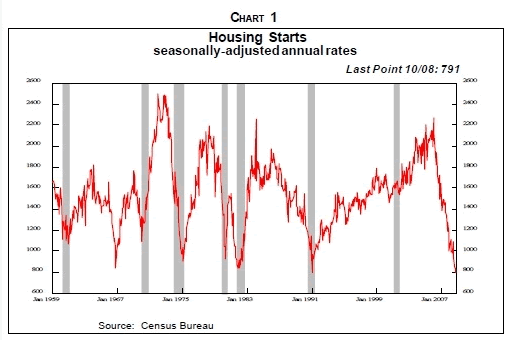
Foreclosure Sales
As lenders spilled foreclosed houses on the market, they were sold for only 70% of the unpaid loan balance in the third quarter compared with 78% in 2007, and losses averaged 44% of the loan balance compared with 29% a year earlier. With about 40% of existing home sales coming from foreclosures, or "short sales" in which the mortgage amount exceeds the house's value, the prices for selling homeowners and builders are forced to decline to compete.
25% More
Existing home prices are down in October 20% from their peak in October 2005 as measured by the National Association of Realtors, and 21% from their second quarter 2006 peak according to the less-upward biased Case-Shiller index (Chart 2). Curiously, a survey found that in the second quarter, 62% of homeowners believed their houses had appreciated in the last year even though 77% had fallen over that time and only 19% had risen, according to Zillow. Another survey found that 91% believe that a house is the best long-term investment. A third poll revealed that 32% think this is a good time to buy stocks, but 51% believe it's a good time to invest in a home. We wonder if that optimism will persist if our long-held forecast of a 37% peak-totrough decline holds.
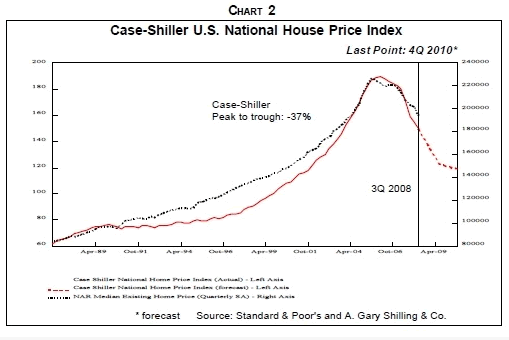
Underwater
At present around 12 million homeowners, a quarter of those with mortgages, are underwater with their houses worth less than their mortgages. Among those who bought their homes in the past five years, 29% are underwater. If our forecast of a 37% house price fall is reached, about 25 million, or almost half the 51 million with mortgages, will be underwater. Adding in the 24 million who own their houses free and clear, and one-third of the total will be in trouble. The destruction of the American Dream of homeownership for so many people will force a political response, even though the cost of subsidizing their mortgages down to their house values would be about $1 trillion.
Financial Problems
The woes of financial institutions also persist, fed by bad mortgages and increasingly by other troubled assets. The extreme stress on the financial system here and abroad is manifested in two clear ways: first, the consolidation and disappearance of many previously impregnable financial institutions and second, by the need for huge and continuing government bailout in order to preserve the integrity of the financial structure and, hence, the world's economies.
The list of the departed is well known: Bear Stearns, WaMu, Lehman and Wachovia disappeared while Merrill Lynch arranged a shotgun marriage with Bank of America and Morgan Stanley and Goldman Sachs converted to the safety of bank holding companies.
The FDIC recently announced that the institutions it insures had only $1.7 billion in earnings in the third quarter, down from $28.7 billion a year earlier. And financial troubles aren't confined to banks. Many hedge funds have suffered huge losses on their highly leveraged positions this year. And their sales of securities to limit further losses and to meet investor redemptions are adding downward pressure on many markets. In some, assets are down 50% while others are folding their tents and still others are limiting redemptions, only adding to investor restiveness. Redemptions are expected to jump early next year.
Diversification
Many endowment and pension funds have been hard hit, especially those with heavy alternative investments in hedge funds, private equity funds, venture capital, commodities, currencies, emerging market stocks and bonds, real estate, junk securities, etc. Diversification is a great idea -- if it works! But as we've noted continually in Insights for more than 10 years, there are tremendous amounts of hot money flowing around the world. And whether it's managed on the basis of fundamental factors, momentum, technical analysis, etc., it all tends to end up on the same side of the same trade at the same time.
So when stocks get clobbered, as they have since October 2007 (Chart 3), and force out hot money, it will also retreat from otherwise unrelated long positions in, say, grains, to conserve capital. Many institutional investors believe in the Modern Portfolio Theory of diversification, but erroneously thought that alternative investments would have zero or better still, negative correlation with their basic equity holdings. They also became convinced that commodities and foreign currencies were asset classes like equities and bonds, and merited 5%, 10% or 15% of their portfolios. They're learning the hard way that all those correlations have proved to be close to 100% and that commodities and currencies aren't asset classes but speculations.
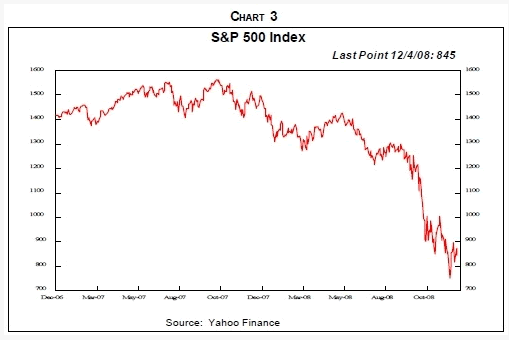
The Overarching Reality
Washington policymakers do not appear to have understood the overarching reality -- the massive and painful deleveraging of the immense leverage accumulated by the household and private financial sectors over the last three decades (Chart 4). They were also initially preoccupied with a philosophy of non-intervention in the private sector and with concerns with creating moral hazard if they bailed out troubled financial institutions. Furthermore, they've been making up the game plan as they go along. Last summer, Secretary Paulson told Congress that the $700 billion bailout money would be used primarily to buy troubled mortgages and mortgage-related securities from banks. Somehow, that would encourage banks to resume lending, but we never understood how.
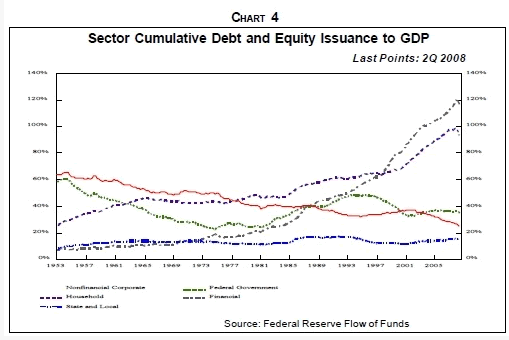
A TARP For All
Even though the majority of the $700 billion TARP money is yet to be committed, that total is only a small piece of the $4 trillion-and-counting sum the federal government has made to bail out the financial sector.
Included in that total beyond the $700 billion TARP program is $350 billion in FDIC guarantees on bank-issued debt, and Goldman Sachs, JP Morgan Chase, Morgan Stanley and Bank of America quickly raised $26 billion with Citigroup and Wells Fargo planning to follow. Then there's an estimated $1.3 trillion from the Fed to buy frozen commercial paper, $540 billion to buy commercial paper and other short-term debt from money market funds to stop the run on them, the new $200 billion Term Asset-Backed Securities Loan Facility (TALF) to back credit card, auto, student aid and small business loans and the $600 billion to buy mortgage-backed securities and GSE debt.
Worst Since The 1930s
Of course, in what will probably be the worst financial crisis and deepest recession since the 1930s, it's not surprising that Depression-era bailout structures are being copied. The Reconstruction Finance Corp., instituted by President Hoover in 1932, bought positions in over 6,000 financial institutions to the tune of $50 billion, not adjusted for inflation or the growth of the economy since then. The government got senior voting rights to control these firms and barred dividend payments to shareholders until the government was repaid.
The worldwide recession is redirecting sovereign wealth money homeward. For instance, seven sovereign wealth funds in the Persian Gulf region are expected to lose 15% of their value, or $190 billion, this year, cancelling the likely $198 billion growth in crude oil revenues.
It's interesting that the Fed, with its new commercial paper program, is lending directly to nonbank corporations for the first time since the 1930s. But then the Fed can lend to anyone, you included, under "unusual and exigent" circumstances. The Fed is, after all, the nation's lender of last resort.
And don't worry about the remaining $370 billion in TARP money being committed. Detroit automakers want $25 billion. Homebuilders want money from somewhere for their $250 billion bailout, mentioned earlier. Banks not included in the initial nine to receive TARP money in the form of preferred stock purchases worry that if they don't ask to be included, they'll appear too weak to qualify. Many of the nation's 6,000 small, non-publicly traded banks want their share of the government goodies even though they can't issue preferred shares and warrants.
Spreading Financial Woes
As consumers retrench and eliminate discretionary spending, they are increasingly regarding monthly payments on credit cards, auto, student and home equity loans as discretionary. When it's a choice between putting food on the table or making a credit card payment, financial responsibility is suffering. Delinquencies and charge-offs in these consumer loan categories are mounting with a 9% increase in auto loans 30 days past due in the second quarter vs. a year earlier and an 11% rise in those 60 days overdue.
Even upscale-oriented American Express, where over half its revenues come from fees paid by merchants, is suffering as charge volume falls and delinquencies and charge-offs on its credit cards rise, leaping 6.7% in September from 3.6% a year earlier. Consequently, the firm recently became a bank holding company so it could qualify for TARP money and hopes to get a $3.5 billion infusion. Credit card issuer Capital One has received preliminary approval for $3.55 billion in TARP money. Credit card issuers are also reacting to weakening volume and jumping charge-offs by raising interest rates and fees.
Student loans more than doubled from $41 billion in school year 1997- 1998 to $85 billion in 2007-2008, but almost all of the growth was in private loans, with subsidized federal aid relatively flat. And delinquencies are jumping in that segment. SLM, or Sallie Mae, the largest private student lender, reported a delinquency rate of 9.4% in September vs. 8.5% a year earlier. Parents, suffering from stock losses and the disappearance of home equity, are no longer able to bail out their debt-swamped offspring. Meanwhile, SUV and other vehicle owners who are now upside down on their auto loans due to weak used vehicle prices have limited zeal to keep up on loan payments.
TALF
Adding the general freezing of credit markets to these conditions and it's not surprising that investor buying of securitized consumer loans, which normally provide the funds to make fresh loans, has dried up. In October, there was only one $500 million deal compared to $50.7 billion a year earlier. And the interest cost has leaped. From June to October, the risk premium on a triple A credit card deal jumped from 3.2 percentage points over 2-year Treasurys to 4.67. Treasury Secretary Paulson recently said that that market "is currently in distress, costs of funding have skyrocketed and new issue activity has come to a halt."
So the government bailouts that we predicted in our October Insight have commenced. The Department of Education is buying $6.5 billion in federally-guaranteed loans, which doesn't affect troubled private student loans directly but does bolster the student loan market overall.
Much more importantly, the government in late November initiated the Term Asset-Backed Securities Loan Facility (TALF) under which the New York Fed will extend up to $200 billion in nonrecourse loans to holders of asset-backed securities backed by highly-rated auto, student, credit card and small business loans. The program may be expanded later to include commercial and residential mortgage-backed securities. The Treasury is kicking in $20 billion from TARP to absorb any losses, as noted earlier.
The hope is that this $200 billion infusion will re-ignite consumer loans. But, as discussed in our October report, leaping delinquencies and the eventual huge writedowns by financial institutional holders of bad consumer loan-related securities suggest that the zeal for consumer loans on the part of lenders or investors will remain subdued. Like TARP, TALF is likely to be no more than a bailout for distressed lenders who made a lot of bad loans. Since the Nov. 25 announcement of TALF, yields on bonds backed by credit card and auto loans remain at record levels.
Foreign Financial Woes
Phase 2 of the recession, financial woes, are, of course, a global phenomenon. And so are the responses. The U.K. initiated the direct injection of government money into banks to buy preferred stocks. The British government had hoped to attract some private capital into HBOS and Royal Bank of Scotland, but collapsed share prices left the government with most of the new stock. Barclay's avoided government help, but with its stock down 70% this year, it may ultimately end up with a third of the bank owned by Middle East investors as it raises $10 billion. The Bank of Japan is injecting another $32 billion into the financial system by expanding lending and easing collateral requirements.
Switzerland depends heavily on her reputation as a super-safe haven for international money, and her financial services industry contributes 11.4% to GDP and employs 5.9% of her workforce. Yet the condition of her banks has deteriorated to the point that in October, her Economics Minister had to state publicly that the government would not allow big banks UBS and Credit Suisse to fail. The government is injecting $5 billion into UBS to back $50 billion in illiquid UBS assets. That bank has suffered over $40 billion in losses due to bad mortgage-related securities.
Credit Suisse is in better shape but suffered a $2 billion third quarter loss due to writedowns on mortgage securities and unsold buyout loans as well as currency trading losses. The bank still holds $26 billion in leveraged loans and conventional mortgagerelated securities. Both banks are closing their bond funds for outside investors due to huge withdrawals following losses.
Meanwhile, the Netherlands agreed to inject $13 billion into the banking and insurance giant ING. In 2000, the Spanish central bank introduced its "dynamic provisioning" system that required Spanish banks to build up considerable reserves against potential future losses. As a result, Spanish banks began this year with 200% coverage of nonperforming loans compared with 59% for the average EU bank in 2006. Still, Spain recently set aside $41 billion to fund illiquid assets of her banks. And turbulent market conditions prompted Banco Santander, Spain's largest bank, to unexpectedly announce last month a $9 billion rights issue.
Russia has been floating on a sea of crude oil, but has sunk along with oil prices. Russians are fleeing the ruble for dollars and $83 billion left the country from August to October. The government has raised interest rates and spent heavily to cushion the currency's descent and avoid a repeat of its 1998 collapse. Still, the ruble is down 5% from its August high, and a halving of its current value is forecast. Meanwhile, plunging crop prices and a lack of credit is curtailing Brazil's soaring farm sector.
In Asia, Pakistan, which reluctantly sought a $7.6 billion IMF loan, really needs $10 billion to $15 billion to prevent economic collapse, government officials say. Dubai's pell-mell economic growth has been heavily financed by international debt that may be hard to refinance. South Korea, responding to shortages of foreign currency for her banks and businesses, in October announced a $100 billion government guarantee on foreign currency loans and a $30 billion infusion of dollars into her banks. More recently, that country has problems with high household debt, which leaped from 38% of GDP in 1997 to 66% last year and is probably higher today. And rising credit costs and falling stock and corporate bond prices are slashing the profits of Japanese banks and their ability to provide capital to the international financial system.
Central Bank Responses
Central banks have responded to the global financial crisis in three ways. First, the Fed cut the discount rate and then the federal funds rare repeatedly, starting in August 2007. The Fed has continued this traditional easing approach and other central banks have followed more recently and aggressively, including the European Central Bank, the Bank of England and the central banks of India, China, Australia, Norway, Sweden South Korea, the Czech Republic, Switzerland, Japan and even Indonesia.
Nevertheless, it became clear early on that rate cuts were of limited value since banks were so scared that they didn't want to tend to each other much less customers. The spread between the London Interbank Lending rate on U.S. interbank loans and Treasury bills, which leaped in the summer of 2007, remains wide. Furthermore, central bank rates are approaching zero at which point, as we understand it, they'll stop falling. So the ammunition of rate cuts is almost all shot off. The horse didn't want to voluntarily walk to the water and, besides, the pond is almost empty. Fed Chairman Bernanke recently said, "The scope for using conventional interest rate policies to support the economy is obviously limited."
So the Fed moved quickly to step 2, leading the horse to the water. It introduced a succession of facilities to auction money to member banks, make it available to nonbank government security dealers, etc. The ECB and the Bank of England introduced similar facilities. Last August, the People's Bank of China, her central bank, relaxed credit quotas so most banks can lend 5% more this year and, more recently, allowed local companies to easily sell yuan-denominated debt of three-to-five years' duration. Then China, it increased quotes for state-controlled lenders by $14.5 billion this year, encouraged local governments to support credit guarantee firms and opened new financing channels including loans for mergers and acquisitions and for consumer finance.
India's central bank has repeatedly reduced bank reserve requirements as has China's. And the Fed has attempted to satisfy foreign banks' gigantic demand for Treasurys by mushrooming its currency swap agreements with foreign central banks and then providing unlimited dollars to the ECB, Bank of England and Swiss National Bank for lending to local banks. The top policymakers of the cautious ECB recently called for an "abundant and generalized" capital infusion into banks. But all these central bank efforts resulted in the proverbial pushing on a string. The funds have stayed in the banks and haven't been lent out and entered the money supply to any meaningful degree as banks want nothing but Treasurys. The central banks led the commercial bank horse to water, but he wouldn't drink.
So it's on to step 3 with the Fed and other central banks, as well as governments, investing directly in Fannie and Freddie, AIG, banks, credit card issuers, insurers, etc. here and abroad, buying commercial paper and, most recently, purchasing indirectly credit card, auto, student and small business loan-backed securities and maybe extending later to commercial and residential mortgagebacked securities as well as subsidizing mortgage rates, as noted earlier.
Washington officials cringe at the suggestion that these measures amount to "quantitative easing," the Japanese policy initiated in 2001, because it failed to rapidly spur Japanese bank lending and the economy and arrest deflation. The Bank of Japan drove its target rate to zero with no effect and then tried to hype the quantity of money by buying government bonds, asset-backed securities and even stocks.
Current quantitative easing by the Fed may not be any more successful than it was in Japan since the global financial system is in a classic liquidity trap, as in the 1930s when bankers were defined as people who wanted to lend to those who didn't need to borrow and didn't want to lend to those who did. Today, banks don't want to lend to anyone but the U.S. Treasury.
Consumer Retrenchment
The financial crisis spawned by the collapse of the residential mortgage market and the follow-on Wall Street woes obviously just had to depress the goods and services economy, and it has in Phases 3 and 4 of the unfolding recession. With the collapse in stock prices and evaporation of home equity, consumers have no other meaningful source of borrowing to fund their spending growth in excess of their after-tax income gains. Notice that home equity withdrawals through cash-out mortgage refinancing and home equity loans reached about $900 billion at annual rates, or around 10% of consumer spending. Now it's negative as principal repayment exceeds home equity withdrawals. So consumers' 25-year borrowing and spending binge, as witnessed by their quarter-century saving rate decline (Chart 5) and borrowing rate surge (Chart 6), is over.
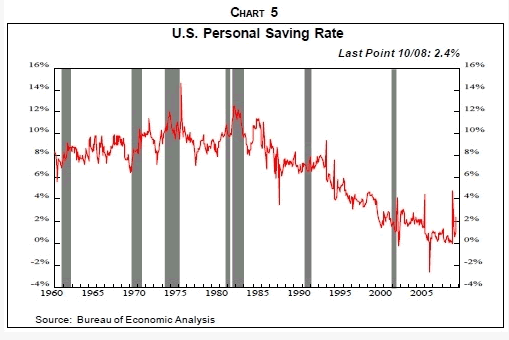
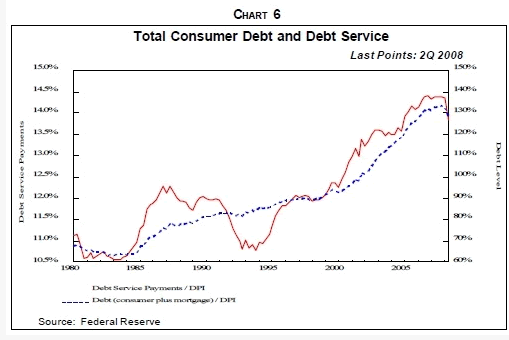
In addition, Americans, especially postwar babies, have saved little for retirement as they concentrated instead on spending. The nosedive in stocks has only made retirement prospects more bleak. In the last 15 months, $2 trillion has disappeared from workplace retirement accounts, including 401(k)s, which now are the primary saving vehicle for 60% of employees.
Jobs
As the housing and financial sectors continue to drop and U.S. consumers retrench, layoffs and unemployment will continue to mount. Payroll employment, which fell 533,000 in November (Chart 7), will probably continue to see monthly declines of 500,000 and the unemployment rate will likely exceed 8% by the end of 2009.
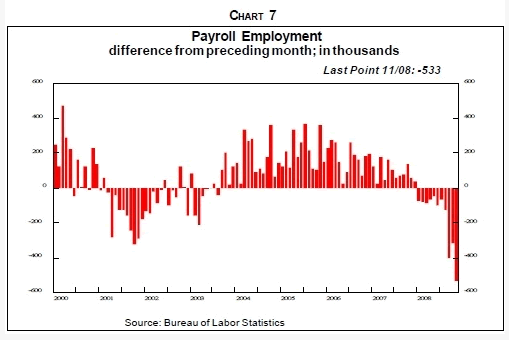
Housing and financial services job cuts are already large and more are coming. But job losses have spread well beyond housing and finance. Manufacturing jobs will continue to be lost as consumers buy fewer domestic goods and foreigners buy fewer American-made products. Retail jobs, normally the employment of last resort for the newly unemployed, are shrinking rapidly. Retail trade employs 10% of the total, but since November 2007, accounted for a quarter of jobs lost, or 320,000, as consumers cut their spending. And another 209,000 retail employees had their full-time hours cut to part-time. Estimates are that 6,100 U.S. stores -- ranging from mom-and-pops to major chains -- will fold this year, up 25% from 2007, and followed by 14,000 stores in 2009.
Impotent Monetary Policy
Conventional monetary policy ease through central bank target interest rate cuts at present is nearly useless, i.e., pushing on a string. Qualitative easing, now actively pursued by the Fed and the Treasury and by central banks and governments abroad, will probably at best only stabilize demoralized financial structures by substituting government securities for questionable assets with little near-term rejuvenation of lending and economic activity.
Also, bear in mind that in democracies, governments are almost guaranteed to be behind the curve in dealing with financial and economic crises. That's because voters elect them to respond to their concerns, not to act in anticipation of yet-unseen problems. Politicians are responders, not planners. In 2006, neither voters nor politicians wanted to prepare for a mortgage market collapse, but voters demanded and got swift action after the crisis unfolded in 2007 and this year.
This means that any resuscitation of the global economies falls on fiscal policy and, as usual, the effects will be delayed, influencing the recovery after the recession rather than shortening its normal course. The incoming Obama Administration is, of course, talking about a sizable fiscal package, perhaps $500 billion to $700 billion, or 3.5% to 5% of GDP.
$700 Billion In Perspective
That's a lot compared to the size of post- World War II recessions (Chart 8). Notice that the 1957-1958 recession, the most severe so far, has a peak to trough decline in real GDP of 3.7%, and the long and deep 1973-1975 downturn saw a 3.1% decline. We're forecasting the most severe recession since the 1930s with a 5.0% decline. You may think that a 5% decline is not a lot, but bear in mind that recessions are more interruptions in growth than economic collapses -- growth that business, consumers, employees and government assume will continue without interruption. Similarly, the 21% decline in the Case-Shiller house price index so far (Chart 2) is small compared with the more-than-doubling during the bubble years. Still, it's very painful for those who made small downpayments at the top and those who extracted their equity when prices were still high.
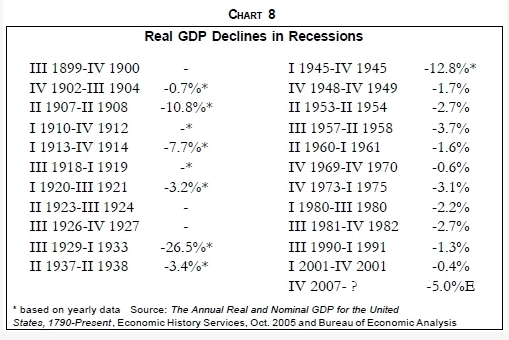
Even a $700 billion fiscal package would probably have limited impact on the recession, and not start to be effective until the end of 2009. And even then, the effects will probably barely offset the negative cumulative recessionary forces. Obama says his proposal will create 2.5 million jobs over two years. But as discussed earlier, payroll declines are likely to continue to run 500,000 per month, so his program would only offset five months of recessionary losses.
Phase 4
Phase 4 of the recession, its globalization, is clearly underway with almost every major country's economy falling whether or not the official recession label has yet been applied. One indicator of weakness is the 2.4% decline in global semiconductor sales in October after a 2.1% fall in September from a year earlier, reflecting softness in computer and cell phone sales. The worldwide turndown is driven by housing slumps, notably in Ireland, the U.K., Spain, Australia and China. U.S. financial woes have spread to almost all major financial institutions worldwide. And consumer spending has been weak in Europe and Japan. U.S. consumer spending accounts for 71% of GDP but less than 60% in all other G-7 countries except the U.K. Sure, much more of healthcare and education expenditures tend to come from government, not consumer pockets in those lands, but households have traditionally been more cautious spenders than Americans, especially in recent years.
And this introduces another key reason for global recession -- retrenchment of U.S. consumers, which depresses U.S. imports on which the rest of the world depends for growth. The huge U.S. trade deficit is the counterpart of the rest of the world's huge surplus.
Commodities
Obviously, the commodities boom is over (Chart 9). Prices of energy, base and precious metals and agricultural products are all down significantly from peak prices. The global recession has reversed the earlier excess of demand over supply.
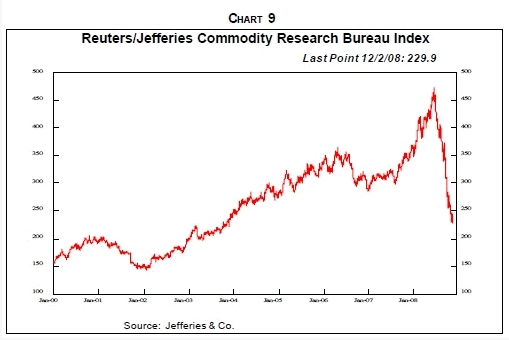
Also, institutional and individual investors who earlier rushed into commodities under the belief that they are a legitimate asset class like stocks and bonds are stampeding out even faster. The financial crisis has also made investors wary of structured notes and other commoditylinked instruments -- and of the firms espousing them.
Tsunami In The Swimming Pool
As noted at the outset, the first two phases of the recession were largely financial, the residential mortgage collapse and the following Wall Street woes. Then, like a tsunami in a swimming pool, that financial tidal wave rolled to the other side and inundated the goods and services economy, with Phase 3, consumer retrenchment, and Phase 4, global slump. Now the tsunami is being reflected back to the financial side of the pool in three ways.
First, retrenching consumers will keep pushing up delinquencies on credit cards, home equity, auto and student loan debt, which will result in big writedowns for their many institutional holders. Collectively, these four categories amount to $4.4 trillion, dwarfing the $0.7 trillion in subprime loans.
Commercial real estate debt is the second problem area, and of the $3.5 trillion outstanding, $800 billion is in commercial mortgage- backed securities and $2 trillion in commercial mortgages held in regional and community banks. As vacancies rise, big writedowns will follow.
Third is nonfinancial leveraged loans and junk binds. Delinquencies have barely risen from rock bottom levels, but will as anticipated by yield spreads and 20% junk bond yields. Recession-depressed revenues here and abroad, collapsing commodity prices (Chart 9) and the leaping dollar that will turn earlier currency translation gains to losses, will all slaughter the corporate earnings of nonfinancial corporations, so far relatively untouched by the financial recession. So delinquencies and charge-offs of junk securities will leap and many investment-grade debts will be pushed into junk territory. Junk bond spreads vs. Treasurys now imply a 21% default rate, higher than in 1933 at the bottom of the Depression. Financial institutions also own a lot of the $3.7 trillion in leveraged loans and junk bonds.
If the tsunami moving from the goods and services side of the pool does considerably more damage to the financial side, it will again be reflected back and even tighter financing will devastate the real economy. Policymakers here and abroad, of course, are trying to erect baffles in the form of bailouts in the middle of the pool to dampen the waves. They are learning that they have to build those baffles bigger and stronger to prevent the waves washing over them. Their moves from Fed interest rate cuts to massive quantitative easing, described earlier, shows they're making progress.
Recession Ends When?
If policymakers succeed in containing the mortgage mess and bailing out financial crises related to consumer borrowing, commercial real estate and junk securities -- and other financial problems we haven't explained in detail -- then the recession may well end at the end of 2009 as massive fiscal stimulus begins to take hold. If not, it probably will extend well into 2010 and perhaps beyond.
To end the crisis, four developments are needed, in our view. The elimination of excess house inventories will probably continue until at least the end of 2010, as discussed earlier. The writedowns and recapitalizations of financial institutions -- at least those related mainly to mortgage-related problems that have unfolded so far -- are well along.
Subsidizing the mortgages of underwater homeowners is beginning to develop. And of course the quicker the excess house inventories are eliminated, the more limited will be further house price declines and the fewer will be the additional homeowners who will slip under water. Bailouts of bad loans and securities in the three additional areas we've identified are big unknowns in terms of cost and feasibility. Nevertheless, policymakers are gaining experience as they grope their way through the current round of bailouts and may be real pros when further big problems surface.
The Dollar
At the end of last year, we forecast that the dollar would end its seven-year slump and rally later in the year against most currencies, but not the yen. And it did, starting in July. It was obvious a year ago that far too many were negative on the greenback. As with commodities, many institutional and individual investors considered foreign currencies as an asset class, worthy of a certain percentage of their portfolio.
Much more importantly, we were forecasting a major global recession and reasoned that, as usual in times of trouble, the dollar would be the global safe haven. We didn't expect the U.S. economy to improve but that the rest of the world would join America in the tank. The greenback would be the best of a universally bad lot. We expect the dollar to keep rising for the next 5 to 7 years, continuing the long- run pattern.
Profits
With the nonfinancial sector joining financial businesses in full retreat, domestic corporate earnings will be decimated in coming quarters, as discussed earlier. And U.S.-based multinationals will also be clobbered by weak foreign revenues and the strong dollar, which will make foreign earnings worth less in dollar terms. Some 30% to 50% of revenues of consumer staple companies like PepsiCo, Sara Lee and Campbell Soup come from abroad. With our forecast of a severe recession, we look for corporate profits, as defined by the Commerce Department, to fall 48% from their peak in the third quarter 2007 to the fourth quarter 2009, and to drop 32% from 2008 to 2009.
P/Es and Stock Prices
Our forecasts imply S&P 500 operating earnings of $40 per share in 2009, down 35% from our $62 estimate for this year. That may sound extreme, but not for the most severe worldwide financial crisis and deepest global recession since the 1930s. At stock market bottoms, the S&P 500 P/E tends to be in the 10-12 range. But low interest rates normally push up P/Es and 10-year Treasury now yield 2.66%, and will probably be even lower later while 30-year Treasury bonds are now at 3.0%, our long-held target, and also a low in recent decades, but may drop further.
So a P/E of 15 at the stock bottom sounds reasonable, but would put the S&P 500 index at 600 then, down 32% from here and 61% below its record close on Oct. 9, 2007. Wow! Earlier, we warned of the number 777, not the Boeing airliner model but the low on the S&P 500 in 2002. If it were breached, we noted, then the bear market that started in early 2000 would still be intact, and all of the rally from the 777 low in October 2002 to the peak five years later would merely be a rally in a bear market. Last month, the S&P 500 fell below 777. It has since bounced, but probably not for long as new lows lie ahead.
There are other reasons to expect considerable further weakness in stocks. High dividends can support stocks at least to a degree, and dividend yields in Europe are meaningful, averaging 5.2%. But not in the U.S. where the S&P 500 yield is a miserly 2.5%. And dividend cuts are coming fast and furious. In the U.K., dividends are constrained for financial institutions getting government bailouts, while in the U.S., the financial sector is slashing dividends.
Some 36 of the S&P 500 have cut dividends 46 times this year, axing $33.8 billion, with $30.8 billion coming from financials. Among those S&P 500 firms, about 20% of dividends this year are from financials, down from 34% in 2007. Elsewhere, REITs are cutting payouts, and GM eliminated its dividend. Only 202 S&P 500 companies have initiated or raised dividends 218 times this year, representing payments of $18 billion, with only $2.4 billion being from financials. In 2007, 298 did so and only 12 reduced or suspended dividend payments.
In troubled times, investors tend to withdraw from foreign markets to concentrate on the home scene they know best. That's why bear markets tend to be uniform. U.S. investors sold a net $92 billion in foreign stocks and bonds in the July-September period, a record flight from overseas investments, while foreign investors pulled over $100 billion from stocks in Japan, South Korea and India so far this year. U.S. stocks are actually falling less than most foreign markets.
Deflation
For years, we've been forecasting that chronic deflation of 1% to 2% per year would start with the next major global recession. Well, it's here! In October, the U.S. producer price index fell 2.8% from September and the CPI dropped 1.0%, the biggest decline since before World War II. Sure, the big driver was the decline in energy costs, but even excluding food and energy, consumer prices dropped 0.1%.
The Fed worries that in deflation, offsetting monetary policy is difficult since its target rate has to stop declining when it reaches zero. Of course, the Fed has other tools as witnessed by the quantitative easing discussed earlier. Nevertheless, all these measures amount to leading the horse to water, as discussed earlier, and he may not drink. The deflation in Japan in the 1999-2005 years worried the Fed when it appeared imminent in the U.S. early in this decade, and it still does. Japan again faces chronic deflation, and the Bank of Japan forecast zero change in the CPI (ex food but not energy) for the fiscal year ending March 2010. Fed Vice Chairman Kohn said the lesson from Japan was that "we should be very aggressive in combating deflation."
Deflation encourages saving since money is worth more later. It also spawns deflationary expectations. Buyers anticipate lower prices later by waiting to buy. That sires excess inventories and capacity, which forces prices down. Buyer suspicions are confirmed so they wait even further to buy, generating a self-feeding downward price spiral, as now seen in autos and houses. Deflation also elevates the cost of debts and debt service since both remain fixed in nominal terms but the revenues and incomes used to repay them tend to fall with overall prices.
Deflation fears and other forces have also reduced reducing 30-year Treasury bond yields to our long-held target of 3.0% and completed what we dubbed in 1981, when the yield was 14.7%, "the bond rally of a lifetime." The recent financial crisis has also helped as investors abandon everything else -- stocks and fixed income alike -- in favor of Treasurys.
Deflation results from overall supply exceeding general demand. We have been forecasting the good deflation of excess supply, as in the late 1800s and in the 1920s, due to today's confluence of semiconductors, the Internet, computers, biotech, telecom and other productivity-soaked technologies. But we have allowed for the bad deflation of deficient demand, as in the 1930s, if one of two adverse conditions develop -- widespread financial crises and worldwide protectionism. Sadly, both are real possibilities.
Inflation?
Many, of course, worry not about deflation but inflation due to all the money being pumped out by central banks and governments globally. They no doubt are biased since most have lived only in an era of inflation and don't agree with us that inflation is the result of excess government spending in wars, both hot and cold. In peacetime, deflation reigns. Starting with rearmament in the late 1930s, then World War II and the Cold War with its hot phases, Korea and Vietnam, wartime and inflation persisted for 60 years.
For now at least, all that money from central banks and governments isn't getting outside financial institutions. We're in a liquidity trap. The horse isn't drinking, thank you very much. And if lenders do start to lend, central bankers, with their congenital fear of inflation, will no doubt reel in all that extra credit.
Even if the bank reserves stimulate the money supply with the usual multiplier effect, the credit created will pale in comparison to the destruction of derivatives and other privately-created liquidity due to persistent deleveraging and writedowns.
Finally, the consumer saving spree we're forecasting will probably increase the saving rate by one percentage point per year on average for the next decade. That would generate a cumulative $5.5 trillion and go a long way to offsetting the intervening fiscal stimuli, and then some.
By John Mauldin
John Mauldin, Best-Selling author and recognized financial expert, is also editor of the free Thoughts From the Frontline that goes to over 1 million readers each week. For more information on John or his FREE weekly economic letter go to: http://www.frontlinethoughts.com/learnmore
To subscribe to John Mauldin's E-Letter please click here:http://www.frontlinethoughts.com/subscribe.asp
Copyright 2008 John Mauldin. All Rights Reserved
John Mauldin is president of Millennium Wave Advisors, LLC, a registered investment advisor. All material presented herein is believed to be reliable but we cannot attest to its accuracy. Investment recommendations may change and readers are urged to check with their investment counselors before making any investment decisions. Opinions expressed in these reports may change without prior notice. John Mauldin and/or the staff at Millennium Wave Advisors, LLC may or may not have investments in any funds cited above. Mauldin can be reached at 800-829-7273.
Disclaimer PAST RESULTS ARE NOT INDICATIVE OF FUTURE RESULTS. THERE IS RISK OF LOSS AS WELL AS THE OPPORTUNITY FOR GAIN WHEN INVESTING IN MANAGED FUNDS. WHEN CONSIDERING ALTERNATIVE INVESTMENTS, INCLUDING HEDGE FUNDS, YOU SHOULD CONSIDER VARIOUS RISKS INCLUDING THE FACT THAT SOME PRODUCTS: OFTEN ENGAGE IN LEVERAGING AND OTHER SPECULATIVE INVESTMENT PRACTICES THAT MAY INCREASE THE RISK OF INVESTMENT LOSS, CAN BE ILLIQUID, ARE NOT REQUIRED TO PROVIDE PERIODIC PRICING OR VALUATION INFORMATION TO INVESTORS, MAY INVOLVE COMPLEX TAX STRUCTURES AND DELAYS IN DISTRIBUTING IMPORTANT TAX INFORMATION, ARE NOT SUBJECT TO THE SAME REGULATORY REQUIREMENTS AS MUTUAL FUNDS, OFTEN CHARGE HIGH FEES, AND IN MANY CASES THE UNDERLYING INVESTMENTS ARE NOT TRANSPARENT AND ARE KNOWN ONLY TO THE INVESTMENT MANAGER.
John Mauldin Archive |
© 2005-2022 http://www.MarketOracle.co.uk - The Market Oracle is a FREE Daily Financial Markets Analysis & Forecasting online publication.


